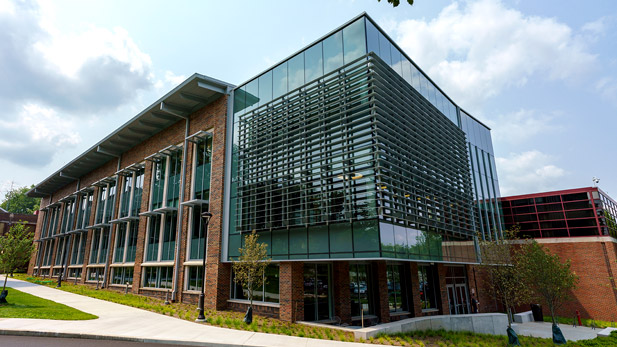New Academic Building Opens ‘Window into Rose-Hulman’

Rose-Hulman held a special ribbon-cutting ceremony to open its new state-of-the-art academic building in time for the 2021-22 academic year.
Rose-Hulman Institute of Technology has opened a new academic building that includes state-of-the-art design studios, collaborative workspaces and science laboratories for students to innovate, make new products and food, and mix complex chemical compounds for research projects.
Inside the 70,000-square-foot, $29 million building, students will be able to take their creative ideas from conceptual renderings to working prototypes and eventual finished products – all within walking distance of laser-cutting devices, 3D printers, machine tools, and CNC machines.
A design feature of the building is a central atrium, with interior and exterior glass making it a “window into Rose” that showcases all the work taking place within the building. Individuals outside the building can see students working together alongside professors on classroom and specialty research projects.
“This new building is the center for the kind of exceptional learning that is the hallmark of a Rose-Hulman education – hands-on, collaborative and sustainable – while being a truly visually stunning structure that fits perfectly within our campus architecture,” said Rose-Hulman President Robert A. Coons.
The middle floor of the new academic building has flexible classrooms with embedded video technology that allow students and faculty to easily learn together and share ideas about computer-aided design concepts. This reinforces the fundamental elements of the institute’s science, technology, engineering and mathematics education that’s revered nationally by higher education peers and helps provide a strong return on investment.
On another floor, chemistry and biochemistry students will be able to use the same advanced equipment as professionals as early as their first year. Connected workspaces also allows for more interdisciplinary opportunities for undergraduate research.
“This new facility offers tremendous opportunities for the types of teaching, hands-on learning and undergraduate research that has come to define a Rose-Hulman education,” said Provost and Vice President for Academic Affairs Rick Stamper. “It is exciting to think about the educational experiences that the students will have in this building and how they will use this education to have a positive impact on the world.”
The building also will be the new home base for the expanding engineering design program; provides more space for chemistry and biochemistry instruction and research; and introduces a new food science development and testing laboratory.
A focal point of the atrium is a dazzling one-of-its-kind interactive “Depth of Field” artwork that showcases engineering, ingenuity, scientific wonder, and artistic beauty. It stands 30 feet tall, 17 feet wide and has more than 13,000 programmable light-emitting diodes speckled throughout 360 custom-made components. Those elements will showcase a multitude of colors every minute throughout each day, reflecting the ever-changing conditions within the building’s environment. The artwork was specially designed by Adam Buente and Kyle Perry of Indianapolis’ Project One Studio.
Another design element are aspects of the building’s air, water, nourishment, light, fitness, comfort, and mind features that impact the health, wellness and the human experience for students, faculty and staff. The building is on track to become Indiana’s first construction project to earn WELL Certification for design and technology. The pioneering building program was established by the International WELL Building Institute.
“This new building will be the epicenter for student learning at Rose-Hulman both now and for future generations,” said Rose-Hulman Board of Trustees Chair and alumnus Niles Noblitt. “With its state-of-the-art amenities, it truly is a revolutionary new space that will thrive as a hub of student activity far into the 21stcentury.”
The building was designed by Indianapolis-based RATIO Architects. Construction was managed by Garmong Construction Services of Terre Haute. Several subcontractors and local laborers were involved in the project since the summer of 2019.
Rose-Hulman’s 2021-22 school year begins September 2.